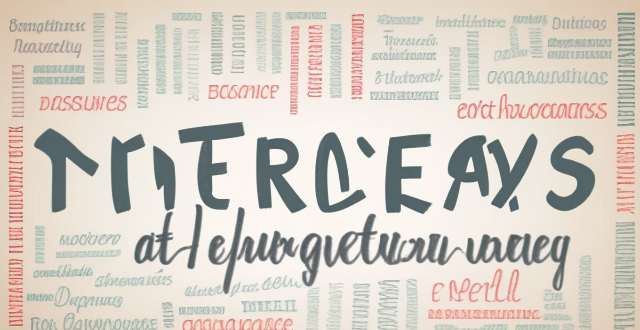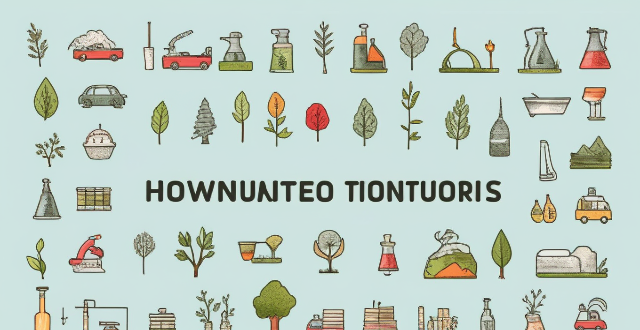Cultural Media

What role does media play in shaping our perception of cultural diversity ?
This article explores the significant role of media in shaping our perception of cultural diversity. It highlights how media exposure to different cultures, representation of cultural diversity, and influence on attitudes and beliefs contribute to understanding and appreciation of cultural diversity. The article encourages critical thinking and active seeking out of diverse perspectives to promote a more inclusive society.

How can sports media cover events in a way that celebrates multiculturalism ?
Sports media can celebrate multiculturalism by embracing diversity in reporting, celebrating cultural traditions, promoting inclusive commentary, and educating audiences. This includes highlighting athlete backgrounds, language inclusivity, featuring pre-game and halftime shows, fan engagement, diverse commentary teams, and interactive education. By doing so, sports media can become a platform for cultural exchange and celebration, enriching the viewing experience and fostering greater understanding among diverse audiences worldwide.

How can we promote cultural diversity in our community ?
Promoting cultural diversity is crucial for fostering understanding and respect among people from different backgrounds. To achieve this, we can organize cultural events, promote multicultural education, encourage intercultural dialogue, support local businesses owned by diverse individuals, increase diverse representation in media, and promote cultural exchange programs. By embracing these strategies, we can create an inclusive and harmonious society where everyone feels valued and respected.

How do food festivals promote cultural diversity and understanding ?
Food festivals are significant events that promote cultural diversity and understanding by offering educational opportunities, exposing attendees to new flavors, building community, impacting the economy positively, providing entertainment, enhancing social media presence and awareness, and promoting sustainability initiatives. These festivals facilitate cross-cultural dialogue, break down cultural barriers, and encourage a shared appreciation for global cuisine.

Is there a risk that cultural fusion could result in cultural homogenization ?
The text discusses the risk of cultural homogenization that comes with cultural fusion, which is the blending of different cultures. This process leads to the loss of distinctive features of individual cultures as they become increasingly similar due to globalization, migration, and other forms of cultural interaction. The phenomenon of cultural homogenization is characterized by the loss of heritage, dominance of global culture, and erosion of local practices. Several factors contribute to this, including globalization, mass media, migration, and economic influence. To mitigate the risk, it is essential to promote cultural preservation and exchange while discouraging the domination of any single culture. This can be achieved through supporting local cultures, cultural exchange programs, education, and policy measures.

Can cultural fusion lead to a loss of cultural identity ?
Cultural fusion, the blending of different cultures, has been a phenomenon for centuries. However, with globalization and the rise of social media, cultural fusion has become more prevalent than ever before. While it can lead to the creation of new and exciting cultural expressions, it can also raise concerns about the potential loss of cultural identity. This article explores whether cultural fusion can indeed lead to a loss of cultural identity by examining the benefits of cultural fusion, the potential loss of cultural identity, and ways to maintain cultural identity amidst fusion.

How does the media influence people's attitudes towards sports ?
The text discusses the media's influence on people's attitudes towards sports. The author outlines several ways in which the media affects people's perceptions of sports, including increased visibility, fan engagement, athlete personas, cultural significance, controversy and debate, and marketing and branding efforts. The author concludes that the media has a powerful impact on how individuals perceive and relate to sports.

How has technology impacted the process of cultural fusion ?
Technology has revolutionized the way we live, work, and communicate, significantly impacting cultural fusion. It has increased accessibility to different cultures through the internet, social media platforms, and messaging apps, leading to a greater exchange of ideas, beliefs, and practices between cultures. Online courses have made education more accessible than ever before, promoting understanding and appreciation of diverse cultures. Travel and tourism have been enhanced by technology through virtual tourism and navigation apps, allowing for greater engagement with local cultures during trips. Food blogging and social media platforms have played a significant role in promoting cultural fusion through cuisine, while online grocery shopping has facilitated the creation of authentic dishes from various parts of the world. Overall, technology has facilitated the exchange of ideas, beliefs, and practices between cultures, leading to greater levels of cultural integration in the future.

How has globalization impacted cultural diversity around the world ?
Globalization has significantly impacted cultural diversity, leadingGlobalization has significantly impacted cultural diversity, leading adaptation but also potential homogen Policy and governance play a role in cultural preservation, with local resistance movements countering globalization effects. Striking a balance between global benefits and cultural preservation is crucial for maintaining diversity.

In what ways can cultural diversity be embraced to foster social harmony ?
Cultural diversity is a rich tapestry that weaves together various beliefs, practices, and traditions of different groups within a society. Embracing cultural diversity is not just about celebrating differences; it's about creating an environment where everyone feels valued, respected, and included. Here are some ways to foster social harmony through the embrace of cultural diversity: Education and Awareness: Integrate diverse perspectives into the curriculum, teach history from multiple viewpoints, include literature and art from different cultures, encourage student and teacher exchanges, organize international conferences and workshops, partner with schools abroad for virtual interactions. Community Involvement: Host multicultural festivals showcasing different traditions, celebrate national holidays from various countries, organize cultural fairs with food, music, and dance, collaborate on projects that benefit all communities, volunteer in diverse neighborhoods, support local businesses owned by immigrants. Media Representation: Ensure media portrays a wide range of cultural backgrounds, avoid stereotyping and promote accurate representations, include diverse voices in news reporting and commentary, create platforms for underrepresented groups to share their stories, translate important information into multiple languages, use technology to bridge language barriers. Workplace Inclusivity: Implement policies that value cultural differences, provide training on cultural sensitivity and awareness, foster an inclusive environment through open communication, encourage the formation of ERGs for different cultural backgrounds, support these groups with resources and recognition, use ERGs as a platform for knowledge sharing and networking. Legal and Policy Frameworks: Strengthen laws against discrimination based on race, ethnicity or culture, enforce these laws fairly and consistently, educate the public on their rights and protections, implement programs to level the playing field for marginalized groups, address historical inequalities through targeted initiatives, monitor progress and adjust strategies as needed. Interfaith Dialogue: Promote understanding between different faiths, organize interfaith events like dialogues, seminars, and celebrations, educate people about the commonalities across religions, create neutral spaces for people of all faiths to gather, encourage community centers to host interfaith activities, provide resources for religious accommodation in public settings. Artistic Expression: Fund arts programs that showcase diverse artistic traditions, offer grants to artists from minority backgrounds, display public art that reflects the cultural mosaic of the community, curate exhibits that tell the stories of different cultures, make museums accessible to all through free entry days or low admission fees, collaborate with community members in the exhibition process.

How can we celebrate and embrace cultural differences in a multicultural society ?
In a multicultural society, celebrating and embracing cultural differences is crucial for fostering understanding, respect, and harmony. To achieve this, it's important to educate oneself and others about different cultures, participate in cultural events, promote diversity in media and entertainment, advocate for inclusivity in education and workplaces, engage in open dialogue, practice empathy and active listening. These strategies can help create a more inclusive and harmonious multicultural society where everyone feels valued and respected for their unique cultural contributions.

How do cultural exchanges through sports influence international relations ?
Cultural exchanges through sports have a significant impact on international relations by promoting mutual understanding, enhancing diplomatic relations, promoting peace and unity, providing economic and social benefits, increasing globalization, and presenting potential challenges such as nationalism and commercialization concerns. These exchanges foster understanding, build bridges between nations, and contribute to a greater sense of global community.

What is the relationship between cultural fusion and social acceptance ?
The text discusses the interplay between cultural fusion and social acceptance, two significant phenomena that shape modern societies. Cultural fusion is defined as the process where different cultures interact, leading to new cultural forms, while social acceptance refers to the degree of support for diversity within a society. The text outlines key points for each concept: diversity, innovation, and interconnectedness for cultural fusion; tolerance, empathy, and equality for social acceptance. It then explores their interaction, suggesting that cultural fusion can promote social acceptance by increasing exposure to different cultures, breaking down stereotypes, and promoting tolerance. Conversely, high levels of social acceptance can foster further cultural exchange and innovation. The conclusion emphasizes the cyclical relationship between the two concepts and their importance in building harmonious societies that embrace diversity and change.

How do cultural factors influence waste reduction practices ?
The text provides an overview of how cultural factors influence waste reduction practices, highlighting the role of cultural attitudes, social norms, education, religious beliefs, economic conditions, and technological advancements in shaping waste management behaviors. It emphasizes that respect for resources, consumerism vs. conservatism, composting traditions, public awareness campaigns, community cleanliness standards, taboos around waste, environmental education, family values, role models, stewardship principles, reincarnation beliefs, interconnectedness philosophies, affordability of disposable products, recycling costs, government incentives, access to technology, digital awareness campaigns, and innovative product design are all aspects of culture that can significantly impact waste reduction efforts. By understanding these cultural dynamics, more effective strategies for sustainable living can be developed globally.

What challenges do people face when participating in cultural exchanges ?
Cultural exchanges, while enriching, present challenges like language barriers, cultural differences, adjustment difficulties, stereotyping, legal and practical issues, and emotional strain. To overcome these, participants should be open-minded, patient, and willing to learn, with preparation through training, classes, and mentorship.

What role does sports play in promoting cultural diversity and inclusion ?
Sports play a significant role in promoting cultural diversity and inclusion by breaking down barriers, educating about different cultures, building communities, and contributing positively to economic development.

What are the benefits of embarking on a cultural exploration journey ?
Embarking on a cultural exploration journey is an enriching experience that offers numerous benefits, including expanding your horizons, enhancing communication skills, boosting creativity, developing cultural sensitivity, strengthening adaptability, building global awareness, forging lasting connections, and promoting personal growth and self-discovery.

What role does media coverage play in shaping public opinion on climate skepticism ?
The text discusses the role of media coverage in shaping public opinion on climate change and climate skepticism. It highlights the influence of biased reporting, sensationalism, balanced coverage, source credibility, and audience perception on how individuals form their beliefs and attitudes towards these issues. The text emphasizes the importance of accurate, balanced, and transparent reporting by media outlets to ensure that the public is well-informed and able to make informed decisions based on evidence.

How can cultural fusion be promoted within multicultural communities ?
Promoting Cultural Fusion in Multicultural Communities emphasizes the importance of understanding and valuing diversity, fostering dialogue and exchange, promoting inclusion and equity, supporting cultural preservation and innovation, implementing policies and practices, and building partnerships and collaborations. These strategies aim to create a community where diverse cultures are celebrated and respected, leading to a richer and more innovative community life.

How do celebrities balance their personal and professional lives on social media ?
Balancing personal and professional lives on social media can be challenging for celebrities. Clear boundaries, separating personal and professional accounts, scheduling posts wisely, engaging with followers appropriately, and seeking professional help when needed are effective strategies for maintaining this balance. By following these strategies, celebrities can maintain a healthy balance between their personal and professional lives on social media while still connecting with their fans in meaningful ways.

Which Asian countries should I visit for a cultural experience ?
Asian countries offer a diverse range of cultural experiences, including festivals, traditional practices, and historic landmarks. Recommended destinations include Japan's Kyoto and Tokyo, China's Beijing and Shanghai, India's Delhi and Agra, Thailand's Bangkok and Chiang Mai, Vietnam's Hanoi and Ho Chi Minh City, and South Korea's Seoul and Busan. Each country offers unique cuisine and activities for travelers seeking a rich cultural experience.

What challenges do athletes from different cultural backgrounds face when competing in foreign countries ?
Athletes from different cultural backgrounds face challenges when competing in foreign countries, including language barriers, cultural differences, time zone changes, and homesickness. These issues can affect performance, mental state, and overall experience during competition. Overcoming these challenges requires resilience, adaptability, and a strong support system.

Can you recommend luxury resorts that offer unique cultural experiences ?
This article recommends several luxury resorts worldwide that offer unique cultural experiences. The Four Seasons Resort Bali at Sayan, Amangiri, Capella Ubud, The Brando, Como Shambhala Estate, Hacienda de San Antonio, and Mandapa, Ritz-Carlton Reserve are among the featured resorts. Each provides a blend of luxurious accommodations and immersive cultural activities such as dance classes, guided hikes, spiritual journeys, cooking classes, and more. These resorts are located in diverse settings, including jungles, deserts, mountains, and coastal areas, offering opportunities to explore local traditions, cuisine, history, and natural beauty.

What is the impact of cultural exchange on globalization ?
This essay explores the impact of cultural exchange on globalization. It states that cultural exchange plays a crucial role in enhancing mutual understanding and respect among nations, promoting economic growth and development, fostering international collaboration and cooperation, encouraging tourism and travel, and preserving cultural heritage and traditions. The essay concludes that as our world becomes increasingly interconnected, cultural exchange will continue to play a vital role in shaping our future together.

What are the benefits and drawbacks of cultural fusion in education systems ?
Cultural fusion in education systems can enhance global awareness and improve intercultural communication, but it may also lead to a loss of cultural identity and stereotyping. To maximize its benefits, cultural fusion should be implemented thoughtfully and effectively.

What is cultural fusion and why is it important ?
The text discusses cultural fusion, which is the blending of different cultural elements from various backgrounds. This process involves exchange, adaptation, and integration of traditions, customs, languages, cuisines, arts, etc. Cultural fusion is important because it promotes diversity and inclusivity, drives innovation and creativity, facilitates global understanding and peace, enhances economic opportunities, and supports sustainable development. It is essential for promoting harmony, innovation, and sustainability in an increasingly interconnected world.

What are some must-visit cultural sites around the world ?
Culture is an integral part of our lives, and visiting cultural sites around the world can be a life-changing experience. Here are some must-visit cultural sites that you should consider adding to your travel bucket list: 1. The Great Wall of China 2. Machu Picchu, Peru 3. Angkor Wat, Cambodia 4. Taj Mahal, India 5. Colosseum, Italy

How can we overcome language barriers in cultural exchange ?
Strategies for overcoming language barriers in cultural exchange include learning basic phrases, using technology, being patient and respectful, practicing active listening, and seeking out cultural exchange opportunities.

What are the cultural challenges faced by international students ?
This article discusses the various cultural challenges that international students face when studying abroad, including language barriers, academic differences, social integration, daily life adjustments, and ethical dilemmas. It also provides coping strategies for overcoming these challenges, such as practicing the local language, participating in cultural exchanges, seeking mental health support, proactively communicating with professors and peers, and embracing differences with curiosity and openness. The author emphasizes that while these challenges can be daunting, they also offer valuable opportunities for personal growth and global understanding.

What role does cultural fusion play in globalization ?
Cultural fusion plays a significant role in globalization by enhancing cross-cultural understanding, promoting innovation and creativity, facilitating economic growth, and enhancing tourism experiences. It refers to the blending of different cultures, traditions, and practices from various parts of the world. This process has become increasingly important as globalization continues to bring people closer together through trade, travel, and communication technologies.